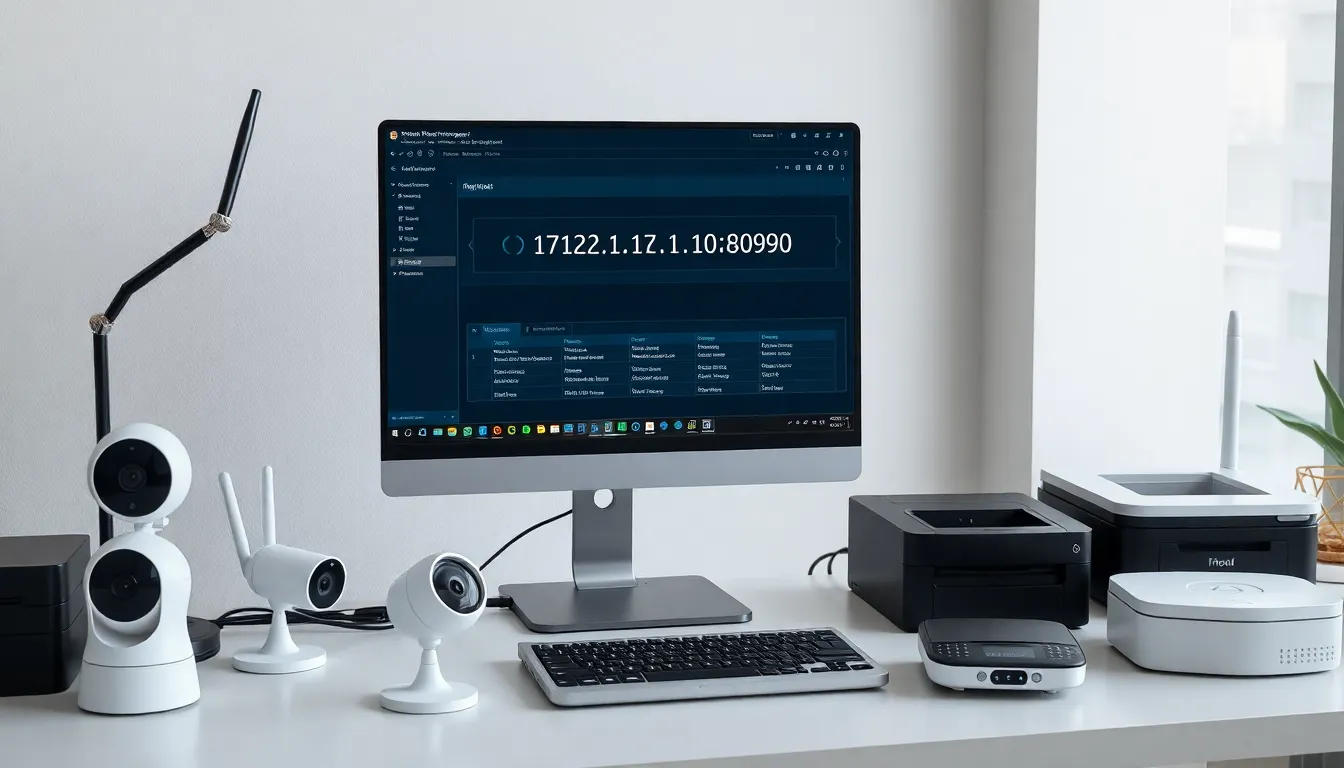In the vast ocean of IP addresses, 172.17.1.10:8090 might not sound like a rockstar, but it’s got some serious backstage passes to your network’s inner workings. This little number is more than just a string of digits; it’s a gateway to understanding how devices communicate and share data. If you’ve ever wondered what goes on behind the scenes of your digital life, this is your chance to pull back the curtain.
Imagine 172.17.1.10:8090 as the quirky neighbor who knows all the gossip but also has the best Wi-Fi. Whether you’re troubleshooting network issues or simply curious about how things connect, this address holds the key. Dive in and discover the secrets lurking within this unassuming IP, and who knows? You might just become the tech-savvy hero of your circle.
Table of Contents
ToggleOverview of 172.17.1.10:8090
The IP address 172.17.1.10 operates within a private network, typically utilized in various local area network (LAN) environments. This address often serves as a key point for devices to communicate effectively, reflecting its importance in network topology.
Port 8090 is associated with specific services, often linked to applications or web servers. Such services vary widely, from web interfaces for configuration to proprietary applications tailored for specific tasks. Understanding the purpose of port 8090 enhances the ability to manage and navigate network activities successfully.
Network administrators frequently monitor this IP address to streamline operations and troubleshoot issues. Commonly, they check for connectivity and data flow since these factors are critical in maintaining optimal performance. Tools such as ping and traceroute can help assess the effectiveness of communication through this address.
Devices connected to the 172.17.1.10 address may include printers, cameras, or smart devices within a home or office. Each device relies on a unique IP to ensure seamless operation, facilitating data exchange and control. Configuration of these devices can often be accessed through the web interface at this address, simplifying management tasks.
Security measures around this IP address and port combination focus on preventing unauthorized access. Firewalls and access control lists are routinely employed to enhance safety while maintaining functionality. Knowledge of these security practices ensures proper access management without compromising network integrity.
Exploring 172.17.1.10:8090 provides valuable insights into network operations. Each interaction with this address can reveal underlying patterns, functioning as a gateway to a deeper understanding of network behavior and efficiency.
Use Cases of 172.17.1.10:8090

The IP address 172.17.1.10:8090 serves multiple practical purposes, particularly in local network settings.
Accessing Applications
Accessing applications through this IP address simplifies user interaction. Users connect to web-based services hosted on port 8090, enabling configurations of devices like printers or smart cameras. A straightforward web interface often appears when navigating to this address, providing essential settings. Configuration options for proprietary applications also reside here, allowing for customized features that enhance performance. Users rely on this access for real-time adjustments and management of their networked devices.
Remote Monitoring
Remote monitoring functionalities rely heavily on the capabilities of 172.17.1.10:8090. This IP serves as a central hub for overseeing device activities and statuses across the network. Administrators employ this address to track performance metrics and detect anomalies. Real-time data visualization tools often utilize the connection, providing insights into device health. The ability to monitor all connected devices remotely promotes proactive management and quick response to issues, supporting efficient network operation.
Technical Specifications
The specifications for 172.17.1.10:8090 focus on networking capabilities and port utilization. Understanding these elements is key to optimizing performance.
Networking Requirements
Devices connecting to 172.17.1.10 typically need specific configurations for proper communication. Network settings must align with DHCP or static IP assignments. The network infrastructure requires a compatible subnet mask, often set to 255.255.0.0 for this private IP range. Additionally, ensuring proper DNS settings enables seamless domain resolution. Firewalls must permit traffic on port 8090 to facilitate access to web applications. Network administrators often conduct bandwidth tests to evaluate performance and confirm connectivity. Optimization of these requirements enhances overall network efficiency.
Port Configuration
Port 8090 plays a critical role in accessing applications hosted on 172.17.1.10. This port supports a variety of services, particularly web-based interfaces for device management. Configuring the port involves ensuring it’s open on the router and firewall settings. Users typically access the web interface by entering the full URL format, which includes the IP address and port number. Regular monitoring of port status allows administrators to detect potential issues early. Security measures surrounding port 8090 are crucial, given its exposure to possible vulnerabilities. Engaging in routine updates and audits helps maintain secure configurations.
Troubleshooting Common Issues
Accessing 172.17.1.10:8090 may present users with various connectivity challenges. Check network cable connections first, ensuring devices are correctly plugged into the LAN. Ensure the IP address has not been mistakenly changed; a static IP setup often prevents this issue.
Verify that the port, 8090, remains open in firewall settings. Many firewalls block unauthorized access, hindering the connection to the web interface. Administrators can resolve this by reviewing firewall rules and ensuring traffic is allowed on port 8090.
Ping tests provide insights into network responsiveness. Conduct a ping from a command prompt to determine if the address is reachable. If there’s no response, consider potential issues with network routing or address assignments.
Check device configurations associated with this IP address. Inconsistent DHCP settings could lead to incorrect IP assignments. A simple review of the assigned devices often clarifies connection issues.
Evaluate network bandwidth, especially if multiple devices compete for resources. High network traffic may slow down access to 172.17.1.10:8090. Bandwidth testing tools can help identify bottlenecks.
Rebooting the router or switch can solve many temporary networking problems. Restart the devices involved to refresh connections and re-establish proper communication. This action often clears minor disturbances that disrupt access.
Keep in mind security settings and user permissions may restrict access. If using a web interface, ensure valid credentials are in use for login. Consult network documentation for specific permission details.
Regular updates for device firmware and network components are vital. Ensure updates incorporate security patches, enhancing overall network health. Maintaining current software facilitates smooth operation and reduces the risk of recurring issues.
Security Considerations
Security considerations surrounding the use of 172.17.1.10:8090 are essential for maintaining network integrity. Firewalls play a critical role in safeguarding the network by blocking unauthorized access. Access control lists must be implemented to define which users or devices can reach this IP address and its associated port.
Threats exist when exposing services on port 8090, making vigilance crucial. Routine updates of software and firmware help mitigate vulnerabilities. Audit trails provide insights into access patterns, aiding in identifying potential security breaches.
Employing secure protocols, such as HTTPS, enhances communication security between devices and users. Network segmentation can limit exposure by confining sensitive devices to specific network areas. Intrusion detection systems monitor real-time traffic, identifying unusual patterns indicative of attacks.
Regular monitoring of server logs allows administrators to detect anomalies early. Verification of user permissions ensures that only authorized individuals control device configurations. Encryption of sensitive data in transit fosters privacy and security against interception.
Additionally, employing VPNs for remote access can significantly enhance security. Strong password policies limit risks associated with unauthorized logins. Continuous training for users on security best practices cultivates a culture of cybersecurity awareness.
Consider implementing multi-factor authentication for critical access points to bolster security. Planning for incident response prepares teams to act quickly in case of security events. Comprehensive security strategies encompass all aspects of device connectivity and management for 172.17.1.10:8090.
Exploring 172.17.1.10:8090 opens a window into the intricacies of local network management. It serves as a vital tool for device communication and offers a user-friendly interface for configuration.
By understanding its functionality and security measures, users can effectively troubleshoot issues and enhance network performance. Regular monitoring and updates are essential for maintaining a secure and efficient environment.
With the right knowledge and tools, anyone can navigate the complexities of this IP address, becoming more proficient in managing their digital landscape.



